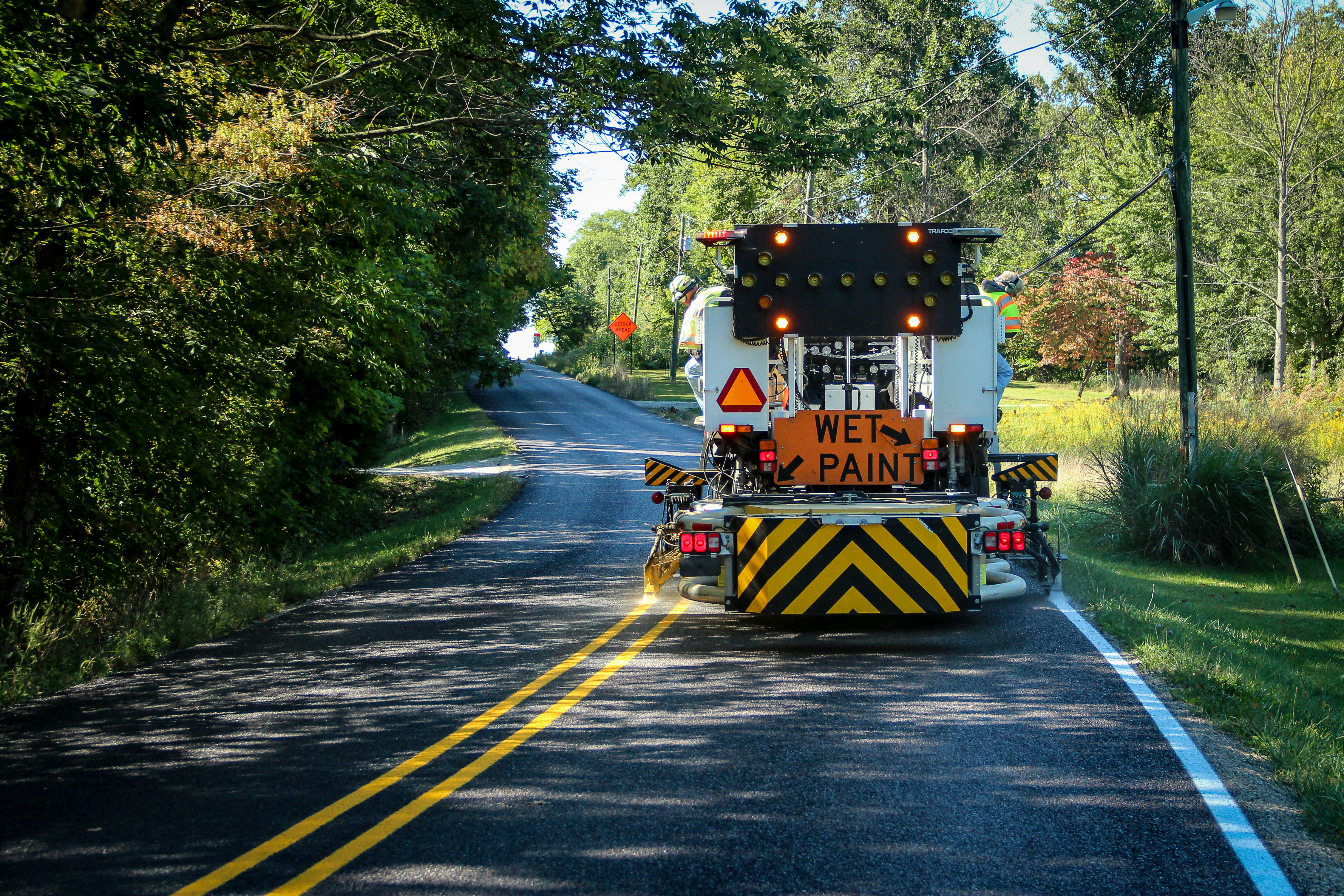
Pavement markings are used to convey messages to roadway users. They indicate which part of the road to use, what conditions lay ahead and where passing is allowed. Pavement markings include both centerline and edge-line paint striping or special markings, such as stop bars, railroad crossings and turn arrows.
INDOT district crews generally repaint pavement markings between April and October. Each year, INDOT measures edge line retroreflectivity, or how much light is reflected back at the driver’s eyes from the car’s headlights. If the retroreflectivity is below the minimum threshold, the edge lines are repainted.
Installation and removal of traffic markings and snowplowable raised pavement markers are required to conform with the Manual of Uniform Traffic Control Devices (MUTCD), the Standard Specifications, and construction project plans.
There are three types of pavement markings:
- Temporary Markings are placed and maintained during the construction stage. They are used in lieu of permanent traffic markings. Pavement markings that conflict with new traffic patterns are removed just before or immediately after the pattern takes effect.
- Longitudinal Markings consist of centerlines, lane lines, edge lines, and barrier lines. Lines may be either continuous (solid) or broken.
- Centerlines are used to separate lanes of traffic moving in the opposite direction. Lane lines are used to separate lanes of traffic moving in the same direction. Edge lines are used to outline and separate the outside edge of pavement from the shoulder. Barrier lines are solid lines of the color and size specified.
- Transverse Markings include such items as channelizing lines, stop bars, crosswalk lines, railroad crossing approaches, parking limit lines, turn arrows, and word or symbol messages.
Materials and Application
Marking materials include waterborne traffic paint, thermoplastic, preformed plastic, epoxy, and snowplowable raised pavement markers. Thermoplastic, preformed plastic, and epoxy are more durable than paint, but cost considerably more.
- Traffic paint may be applied only when the pavement temperature is 40°F or above. Reflective glass beads must be added immediately to the fresh paint.
- Thermoplastic material is supplied in solid form and heated to a liquid state for application. This material is normally used on asphalt pavements.
- Preformed plastic may be used on either asphalt or concrete pavement. The plastic film is at least 60 millimeters thick and molds itself to pavement contours, breaks, and faults under traffic when heated.
- Epoxy contains pigment and epoxy resins and a curing agent. Epoxy is normally used on concrete pavements. Epoxy may be applied only when the pavement temperature is 40°F or above.
Reducing Vehicle Damage
Traffic markings are frequently applied to roadways that are open to traffic. Proper traffic controls and driver attentiveness is essential to protect the traveling public, the pavement marking crews, and the pavement markings during the curing period.
INDOT makes every effort to reduce vehicle damage during and immediately after pavement marking projects. While these efforts may not prevent all damage to vehicles during the process, they substantially reduce the likelihood of damage.
Regular waterborne paint should dry to no tracking 60 seconds after application, although this time may vary depending on temperature and humidity.
INDOT safety efforts include posting temporary reduced speed limits, placing traffic cones to protect the material from traffic during the curing period, or restricting lanes during pavement marking projects.
Longitudinal markings typically use a moving operation, so no work zone is set up. However, INDOT will position rear escort vehicles with warning signs to alert drivers. Drivers should never be between the paint truck and the escort vehicle(s).
A temporary work zone is more likely to be set up during installation of transverse markings.
Below are steps motorists can take to protect their vehicles when driving near fresh pavement markings:
- Use alternate routes.
- Slow down. Higher speeds can cause marking material to splatter before curing.
- Increase distance between vehicles. Leave space between you and other vehicles to reduce damage caused by marking materials.
- Follow posted work zone signage, use caution and consider worker safety when traveling through a work zone.
If a motorist gets pavement markings materials on their vehicle, they should wash the affected area with soap and warm water as soon as possible.
Related Links
- Manual on Uniform Traffic Control Devices
- FHWA Pavement Markings
- Institute of Traffic Engineers
- INDOT Pavement Traffic Markings
Customer Service Contact Information
To report a concern please contact the Next Level customer service number at 855-463-6848 or at INDOT4U.com
